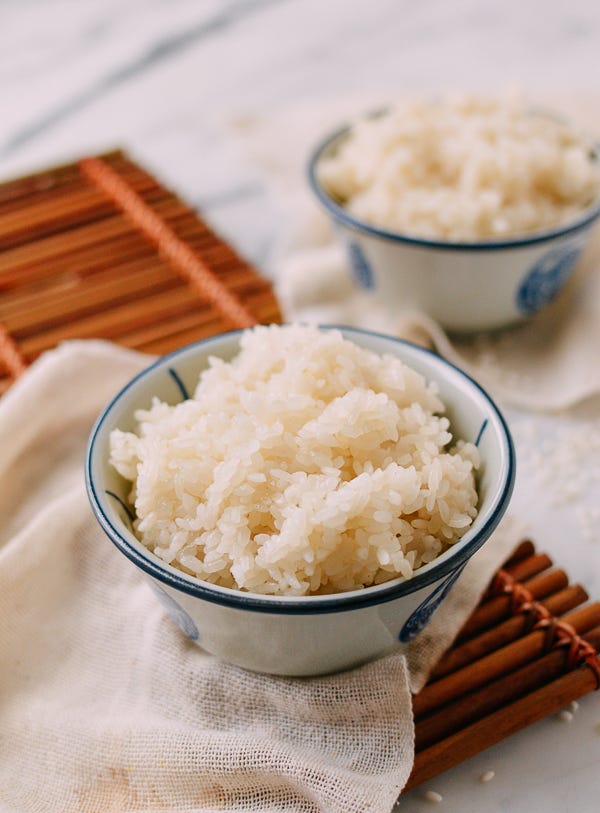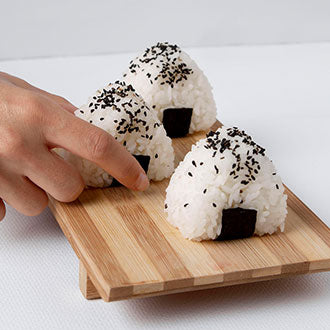What Is Glutinous Rice And Sushi Rice?

Glutinous rice, also known as sticky rice or sweet rice, is a type of rice that becomes sticky and chewy when cooked. It has a higher starch content compared to other rice varieties, which gives it its distinct texture. Glutinous rice is commonly used in Asian cuisine, particularly in desserts, rice cakes, and sticky rice dishes.
Sushi rice, on the other hand, is a specific type of short-grain rice that is seasoned with vinegar, sugar, and salt. It is the key ingredient in making sushi, providing the perfect balance of stickiness and firmness to hold the sushi ingredients together. Sushi rice is also commonly used in other Japanese dishes like rice balls, known as onigiri.
While both glutinous rice and sushi rice are sticky in nature, they differ in their purpose and preparation. Understanding their characteristics and uses is essential in creating delicious and authentic dishes.
Glutinous Rice: Origins, Characteristics, And Common Uses
Glutinous rice, also known as sticky rice or sweet rice, has been a staple in Asian cuisine for centuries. Its origins can be traced back to Southeast Asia, where it has been cultivated for thousands of years. One of the key characteristics of glutinous rice is its high starch content, which gives it its sticky and chewy texture when cooked. This unique quality makes it perfect for dishes like sticky rice with mango, rice dumplings, and glutinous rice cakes. Additionally, glutinous rice is often used as a filling in various Asian desserts. Its ability to hold together well makes it a versatile ingredient in both sweet and savory dishes.
Sushi Rice: History, Properties, And Importance In Sushi Making
Sushi rice, also known as “shari,” has a rich history dating back to ancient Japan. It originated as a way to preserve fish by storing it in fermented rice. Over time, the fermentation process was eliminated, and sushi rice evolved into the sticky and seasoned rice we know today.
The key properties of sushi rice include its short grain size, high starch content, and a balance of sweetness and acidity from the vinegar used in its preparation. These properties give sushi rice its distinct texture and flavor, making it the perfect base for sushi.
In sushi making, the role of sushi rice is crucial. It acts as the foundation for various sushi types, such as nigiri and maki rolls. The stickiness of sushi rice helps to hold the fish or other toppings in place, allowing sushi chefs to create aesthetically pleasing and flavorful bites.
Sushi rice is typically seasoned with a mixture of rice vinegar, sugar, and salt, which gives it a tangy and slightly sweet taste that complements the freshness of the fish. It is this balance of flavors that makes sushi rice an essential component of traditional sushi dishes.
Overall, sushi rice plays a vital role in elevating the taste and presentation of sushi. Its unique properties and flavor profile make it an indispensable ingredient in the art of sushi making.
Glutinous Rice Vs Sushi Rice: Texture And Taste

When it comes to texture and taste, glutinous rice and sushi rice have distinct differences. Glutinous rice, as the name suggests, has a sticky and chewy texture. It clumps together when cooked, allowing it to be easily molded into shapes or used in traditional desserts. The taste of glutinous rice is mild and slightly sweet, which makes it a versatile ingredient for both savory and sweet dishes.
On the other hand, sushi rice has a softer and more tender texture. It is sticky, but the grains remain separate, allowing for a pleasant mouthfeel. Sushi rice is seasoned with vinegar, sugar, and salt, giving it a tangy and slightly sweet flavor. This unique combination of flavors enhances the taste of the sushi fillings and toppings.
In summary, while both types of rice can be sticky, glutinous rice has a chewier texture and milder taste, while sushi rice has a softer texture and is infused with a tangy sweetness that complements sushi fillings.
Comparison Of Texture And Taste Differences Between Glutinous Rice And Sushi Rice
Glutinous rice and sushi rice have distinct differences in texture and taste. Glutinous rice has a sticky and chewy texture, clumping together when cooked. This makes it perfect for dishes like sticky rice dumplings and glutinous rice cakes, which require a sticky consistency. In terms of taste, glutinous rice has a mild and slightly sweet flavor, making it versatile for both savory and sweet dishes.
On the other hand, sushi rice has a softer and more tender texture. Although it is sticky, the grains remain separate, creating a pleasant mouthfeel. Sushi rice is seasoned with vinegar, sugar, and salt, giving it a tangy and slightly sweet flavor. This unique combination of flavors enhances the taste of the sushi fillings and toppings, providing a well-balanced and refreshing experience.
In summary, while both types of rice can be sticky, glutinous rice has a chewier texture and milder taste, while sushi rice has a softer texture and is infused with a tangy sweetness that complements sushi fillings.
Glutinous Rice Vs Sushi Rice: Cooking Methods
When it comes to cooking methods, Glutinous Rice and Sushi Rice require different techniques to achieve their desired textures.
Glutinous Rice is traditionally soaked in water for several hours before being steamed, cooked in a rice cooker, or prepared in a bamboo steamer. This helps to soften the grains and release the starch, creating its signature sticky and chewy texture. Glutinous Rice is often used in Asian desserts or served alongside savory dishes.
In contrast, Sushi Rice is prepared by washing the rice thoroughly to remove excess starch, then cooking it in a rice cooker or on the stovetop. Once cooked, the rice is seasoned with a mixture of rice vinegar, sugar, and salt to give it that tangy and slightly sweet flavor that enhances sushi dishes.
While both types of rice require some preparation, the cooking methods for Glutinous Rice and Sushi Rice cater to their unique textures and taste profiles.
Key Differences In Cooking Methods For Glutinous Rice And Sushi Rice

In order to achieve their respective textures, Glutinous Rice and Sushi Rice require different cooking methods.
For Glutinous Rice, it is traditionally soaked in water for several hours before being steamed, cooked in a rice cooker, or prepared in a bamboo steamer. This soaking process helps to soften the grains and release the starch, resulting in its signature sticky and chewy texture. Glutinous Rice is commonly used in Asian desserts or served alongside savory dishes.
On the other hand, Sushi Rice is prepared by thoroughly washing the rice to remove excess starch. It is then cooked either in a rice cooker or on the stovetop. Once cooked, the rice is seasoned with a mixture of rice vinegar, sugar, and salt to give it the tangy and slightly sweet flavor that enhances sushi dishes.
While both types of rice require some preparation, the cooking methods for Glutinous Rice and Sushi Rice cater to their unique textures and taste profiles.
Glutinous Rice Vs Sushi Rice: Nutritional Value
When it comes to their nutritional value, Glutinous Rice and Sushi Rice offer slightly different profiles. Glutinous Rice is higher in calories and carbohydrates, making it a good source of energy. It also contains some protein and a small amount of fat. On the other hand, Sushi Rice has a similar caloric and carbohydrate content but is lower in protein and fat. Sushi Rice is also a good source of vitamins and minerals such as magnesium, manganese, and selenium. Both types of rice are gluten-free and low in sodium, making them suitable options for those with dietary restrictions. However, it’s important to note that the nutritional value of rice can vary depending on serving size and preparation methods.
Analyzing The Nutritional Content And Health Benefits Of Glutinous Rice And Sushi Rice
When it comes to the nutritional content of Glutinous Rice and Sushi Rice, there are some notable differences. Glutinous Rice is higher in calories and carbohydrates, making it a good source of energy. It also contains some protein and a small amount of fat. On the other hand, Sushi Rice has a similar caloric and carbohydrate content, but is lower in protein and fat. Additionally, Sushi Rice is a good source of vitamins and minerals such as magnesium, manganese, and selenium. Both types of rice are gluten-free and low in sodium, making them suitable options for those with dietary restrictions. However, it’s important to note that the nutritional value can vary depending on serving size and preparation methods.
Glutinous Rice Vs Sushi Rice: Culinary Applications

When it comes to culinary applications, both glutinous rice and sushi rice have their unique uses. Glutinous rice, with its sticky texture, is commonly used in various Asian dishes. It serves as the perfect base for dishes like sticky rice with mango, sticky rice dumplings, and glutinous rice cakes. Its ability to hold together well makes it ideal for shaping into balls or using as a filling for various desserts.
On the other hand, sushi rice is specifically designed for sushi dishes. Its slightly sweet and tangy flavor, along with its stickiness, allows the rice to hold together and provide the perfect texture for sushi rolls and nigiri. Sushi rice is also used in other Japanese dishes like onigiri (rice balls) and chirashi (scattered sushi).
In summary, while glutinous rice is versatile in Asian cuisine, sushi rice excels in creating authentic and delicious sushi dishes.
Exploring The Unique Culinary Applications Of Glutinous Rice And Sushi Rice
Glutinous rice and sushi rice have their own distinct culinary applications that contribute to the diversity of Asian cuisine. Glutinous rice, with its sticky texture, is commonly used in a variety of traditional dishes. It serves as a versatile base for desserts like sticky rice with mango and glutinous rice cakes, allowing it to take on flavors from other ingredients. This type of rice also lends itself well to shaping into balls or using as a filling.
On the other hand, sushi rice is specifically designed for sushi dishes, which are a staple of Japanese cuisine. The sticky and slightly tangy nature of sushi rice enables it to hold together well, providing the perfect texture for sushi rolls and nigiri. Additionally, sushi rice is used in other Japanese dishes like onigiri (rice balls) and chirashi (scattered sushi). Its unique properties and flavor make it essential for creating authentic and delicious sushi experiences.
In summary, while glutinous rice is versatile in various Asian dishes, sushi rice excels in creating authentic and exquisite sushi dishes. Whether it’s the sticky sweetness of glutinous rice or the tangy perfection of sushi rice, both varieties offer culinary experiences that are deeply rooted in their respective cultural traditions.
Conclusion
In conclusion, understanding the differences between glutinous rice and sushi rice is essential for both home cooks and enthusiasts of Asian cuisine. Glutinous rice, with its sticky and stretchy texture, is perfect for traditional dishes like sticky rice dumplings and glutinous rice cakes. It serves as a versatile base for desserts like sticky rice with mango and can take on flavors from other ingredients. On the other hand, sushi rice, with its medium-grain and slightly sticky nature, is the ideal rice for creating authentic and delicious sushi dishes. Its unique properties and flavor make it essential for sushi rolls, nigiri, and other Japanese dishes. Whether you’re craving a sweet and sticky dessert or looking to make a delicious sushi feast, these rice varieties have got you covered.
Summary Of The Distinctions Between Glutinous Rice And Sushi Rice

Glutinous rice and sushi rice may both be sticky, but they are distinct varieties with unique characteristics and culinary uses. Glutinous rice, also known as sticky rice, is a short-grain rice with a sticky and chewy texture. It is commonly used in Asian desserts, dumplings, and rice cakes. On the other hand, sushi rice is a medium-grain rice that becomes sticky when it is cooked and seasoned with vinegar. It is specifically cultivated for making sushi and other Japanese dishes. Glutinous rice is sweeter and has a stronger aroma, while sushi rice is milder in flavor. Understanding these differences is essential for creating authentic Asian dishes and exploring different culinary experiences.
Recommended Uses For Each Type Of Rice In Various Dishes
Glutinous rice and sushi rice have distinct characteristics that make them ideal for different types of dishes. Glutinous rice, with its sticky texture, is commonly used in a variety of Asian desserts, such as sticky rice with mango. It is also used in savory dishes like rice dumplings and glutinous rice cakes. Its ability to hold together well makes it perfect for shaping into balls or using as a filling.
On the other hand, sushi rice is specifically seasoned with vinegar, sugar, and salt for making traditional sushi rolls, nigiri, and other Japanese dishes. Its slightly sticky texture and mild flavor complement the various ingredients used in sushi.
Understanding the recommended uses for each type of rice allows chefs and home cooks to experiment and create authentic and delicious Asian dishes with the right rice variety.
FAQ About Glutinous Rice Vs Sushi Rice: Unraveling The Differences
Q: What is the main difference between glutinous rice and sushi rice?
A: The main difference lies in their stickiness and texture. Glutinous rice, also known as sticky rice or sweet rice, is stickier and more chewy compared to sushi rice, which is a short-grain rice that becomes sticky when cooked.
Q: Can glutinous rice be used interchangeably with sushi rice?
A: No, they are not interchangeable. Glutinous rice is primarily used in desserts, dumplings, and sticky rice dishes, while sushi rice is specifically seasoned with rice vinegar, sugar, and salt for making sushi.
Q: How are the cooking methods different for glutinous rice and sushi rice?
A: Glutinous rice requires soaking before cooking to achieve its desired sticky texture, while sushi rice is rinsed and cooked with precise water-to-rice ratios to maintain its firm yet sticky consistency.
Q: Are there any cultural differences in the use of glutinous rice and sushi rice?
A: Yes, glutinous rice is commonly used in various Asian cuisines for its sticky properties in dishes like Chinese sticky rice and Thai mango sticky rice, while sushi rice is a staple in Japanese cuisine for making sushi rolls and nigiri.
Q: How do the taste profiles of glutinous rice and sushi rice differ?
A: Glutinous rice tends to have a slightly sweet flavor due to its sticky nature, whereas sushi rice has a mild tanginess from the seasoning added during the sushi-making process.

ToroGrill Canada is excited to share our one-of-a-kind and authentic South American BBQ flavors with the wonderful people of Canada. Our journey began with a passion for bringing South America’s rich and vibrant culinary traditions to a new audience, and we have been dedicated to this mission ever since. Our story is one of inspiration, hard work, and the pursuit of excellence. Every recipe, every ingredient, and every cooking technique has been carefully honed and perfected to ensure that when you take a bite of our food, you experience the true essence of South American BBQ.